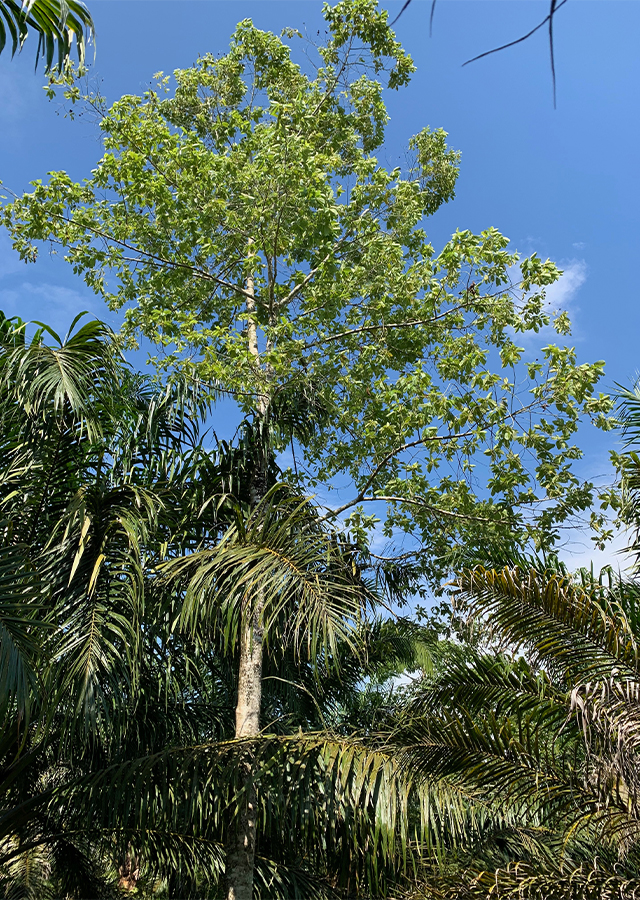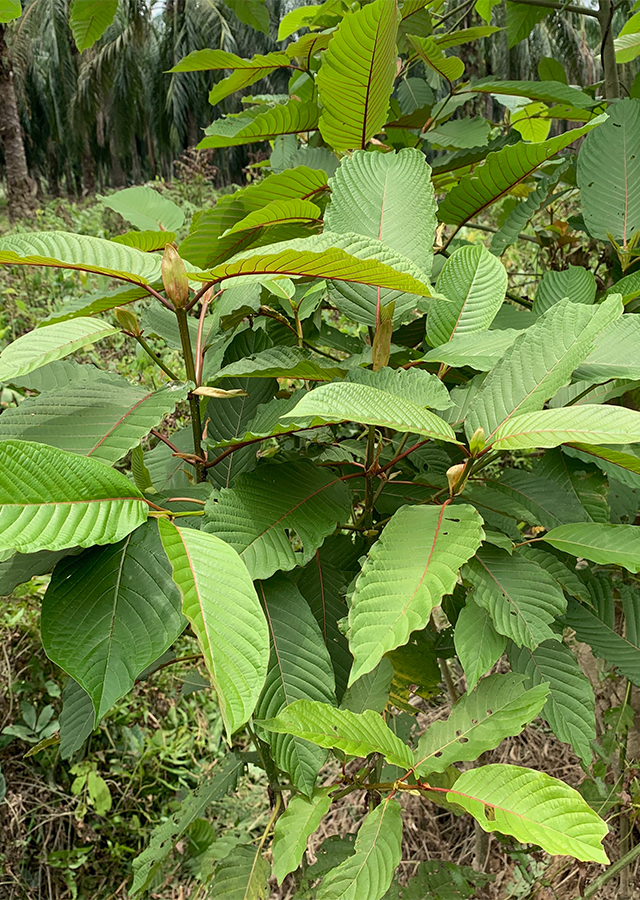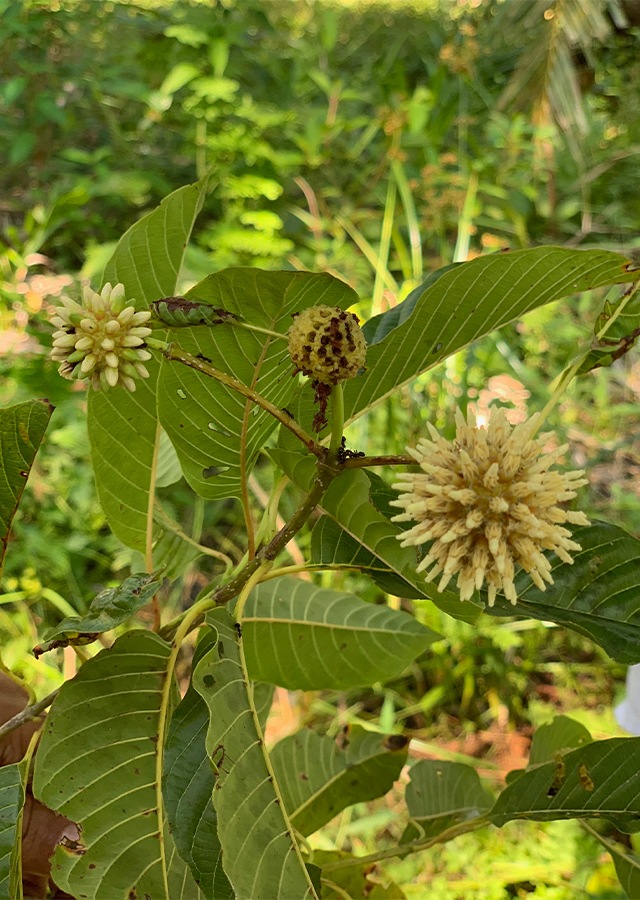Kratom
Mitragyna speciosa Korth.
Rubiaceae
Location in our garden
Principal



Synonym
Nauclea korthalsii Steud.
Nauclea luzoniensis Blanco
Nauclea speciosa (Korth.) Miq.
Habitus
Trees. Perennial, growing up to 10-30 m tall
Part Used
Leaves
Growing Requirements
Full Sunshine
Need Shade
Habitat
Wetland
Forest
Grassland
Overview
Kratom is a tree indigenous to South-East Asia (Borneo, Cambodia, Malaya, New Guinea, Philippines, Sumatera, Thailand). It is mostly grown in the central and southern regions of Thailand, and only rarely grow in the northern part. It is introduced to Vietnam. The plant is often used medicinally in parts of South-East Asia, where it is also used as a substitute for opium. It is cultivated for its leaves in Thailand, Myanmar and Vietnam. In Indonesia, kratom is distributed in Sumatra, Kalimantan and Papua. Kratom has high economic value as herbal medicine and ecological impacts, such as increasing carbon storage in the soil, preventing abrasion, being a place for storing water in the soil, and reducing greenhouse gas emissions.
Vernacular Names
Biak-biak (Malaysian), Bai krathom (Thailand), Mambog (Tagalog-Philippines), Kadamba, Puri (Indonesian).
Agroecology
It grows in open savannah and secondary forest, at low elevations. Kratom prefers wet, humus-rich soils in a protected position. Being a heavy feeder, it requires very rich, fertile soil. It is drought sensitive, and if grown out of its native habitat, sensitive to frost. This plant has the ability to survive live in waterlogged conditions.
Morphology
- Roots - taproot with a lot of lateral roots.
- Stems - erect and branching, with a bole 60-100 cm in diameter.
- Leaves - elliptic, 8.5 to 14 cm long, 5 to 10 cm wide, smaller at the ends of the branchlets, pointed at the tip, rounded or somewhat heart-shaped at the base, and hairy on the nerves beneath. Petioles are 2 to 4 cm long.
- Flowers - yellow, crowded in a round, terminal inflorescences 3 to 5 cm long, corolla tube is 5 mm long, smooth without and hairy within.
- Fruits - oblong ovoid and 5 to 7 mm long, with 10 ridges.
Cultivation
- Propagation is by very fresh seeds or cuttings.
- There is a low strike rate, due to a fungus which attacks xylem tissue.
Chemical Constituents
Kratom has 57 types of compounds, 40 of them are alkaloids (indole alkaloids and oxindole alkaloids). Mitragynine and 7-hydroxymitragynine are included in indole alkaloid compounds as the main compounds of the kratom plant. The content of mitragynine is more commonly found in the leaves with very variable levels, depending on the location of growth. Paynanthine, spesiogynine, spesiosiliatine belong to the oxindole alkaloids group. Other compounds that have been identified in the kratom plant include flavonoids, polyphenols, triterpenoids, triterpenoid saponins, monoterpenes, glucopyranosides, sitosterols, and stigmasterols, and daucosterol.
Traditional Medicinal Uses
Medicinal Uses
- Studies have suggested that the chronic administration of mitragynine can alter cognitive-behavioural function.
- Kratom can have a positive effect on your mood and level of anxiety, could be prescribed both to opiate addicts and to patients suffering from depression.
- A study showed the antioxidant value and anticancer functions of mitragynine (MTG) and its silane-reduced analogues (SRM) in vitro.
Traditional Uses
- In Thailand and Malaysia, reported use as a stimulant, to combat fatigue and enhance physical endurance;
- In Malaysia, it is used for treatment of diarrhea, worm infestation, and as an analgesic and antipyretic; in Perak, pounded leaves are applied to wounds.
- Poultice of leaves applied to upper abdomen for expulsion of worms in children.
In Indonesia, Kratom is traditionally used to increase stamina, treat pain, rheumatism, gout, hypertension, stroke symptoms, diabetes, insomnia, wounds, diarrhoea, cough, cholesterol, typhoid, and increase appetite. The effects of kratom on humans are dose-dependent. At low doses, it has a stimulatory effect and at higher doses, it has a narcotic effect but is not a strong addictive substance.
Part Used
Reference Sources
- Azarius. (No date). Kratom (Mitragyna speciosa) - Encyclopedia. https://azarius.net/encyclopedia/15/kratom-mitragyna-speciosa/. 02-02-2021.
- Fern, Ken. (2014). Useful Tropical Plants Database. Mitragyna speciosa. http://tropical.theferns.info/viewtropical.php?id=Mitragyna+speciosa. 02-02-2021.
- National Center of Biotechnology Information. (2005). Mitragynine. https://pubchem.ncbi.nlm.nih.gov/compound/Mitragynine#section=UV-Spectra. 02-02-2021.
- StuartXchange. (2017). Philippine Medicinal Plants. Mambog. http://www.stuartxchange.com/Mambog. 02-02-2021.
- Wahyono, S., Widowati, L., Handayani, L., Sampurno, O.D., Haryanti, S., Fauzi, Ratnawati, G. & Budiarti, M. (2019). Kratom : Prospek Kesehatan dan Sosial Ekonomi, Jakarta : Lembaga Penerbit Badan Penelitian dan Pengembangan Kesehatan: 1-123.
- Meireles, V., Rosado, T., Barroso, M., Soares, S., Gonçalves, J., Luís, Â., Caramelo, D., Simão, A., Fernández, N., Duarte, A. & Gallardo, E. (2019). Mitragyna speciosa: Clinical, toxicological aspects and analysis in biological and non-biological samples. Medicines. 6(1): 35.
- Gogineni, V., Leon, F., Avery, B. A., Mccurdy, C. & Cutler, S. J. (2014): Phytochemistry of Mitragyna speciosa, ed. 1: 16.

